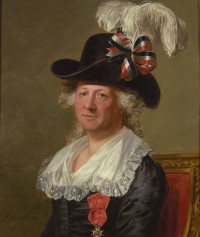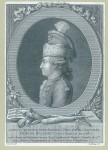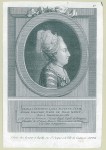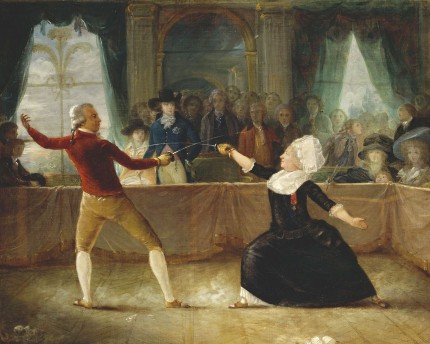 British art dealer and art detective Philip Mould was sleuthing in the saleroom of the Thomas Cornell Galleries in Patchogue, Long Island last November when he came across an arresting portrait of what appeared to be a rather masculine middle-aged woman. Named “Portrait of a Woman with a Feather in her hat” and attributed to painter Gilbert Stuart, the oil painting was part of the estate of Ruth Stone, daughter of Samuel Klein, founder of Edith Bunker’s department store, S. Klein’s.
British art dealer and art detective Philip Mould was sleuthing in the saleroom of the Thomas Cornell Galleries in Patchogue, Long Island last November when he came across an arresting portrait of what appeared to be a rather masculine middle-aged woman. Named “Portrait of a Woman with a Feather in her hat” and attributed to painter Gilbert Stuart, the oil painting was part of the estate of Ruth Stone, daughter of Samuel Klein, founder of Edith Bunker’s department store, S. Klein’s.
His spidey sense tingling, Mould purchased the portrait at the auction and brought it back to his gallery in London for conservation and further research. A thorough cleaning revealed that the artist was not Gilbert Stuart, the American portraitist most famous for having painted the unfinished Athenaeum Portrait of George Washington, a replica of which is the face on the US dollar bill. Old varnish and dirt had obscured the signature of the real artist: Thomas Stewart, an 18th century English painter who is not very well known today, but who starting in the 1780s was a successful painter specializing in portraits of actors. Next to the “T. Stewart” signature is the date “1792.”
Documentary research uncovered that the misattribution to Gilbert Stuart is longstanding. A painting answering to this one’s description is included in Lawrence Park’s 1926 catalogue raisonné of Gilbert Stuart’s work. At some point in the early 20th century, the portrait was sold to an unknown US buyer by Ellen Anne Simonds, who had inherited it by descent from Sir Thomas Pelham Hayes, or perhaps his father Sir John Macnamara Hayes, military surgeon and the personal physician of the future George IV. The original owner was Francis Hastings Rawdon, the 2nd Earl of Moira, a collector of exotica who had also served in the American Revolution. After its move across the Atlantic, the painting disappears from the record.
The cleaning also revealed another telling detail: a noticeable five o’clock shadow on the lady’s face. Moira is known to have owned a portrait of the Chevalier d’Eon, and the Chevalier was known to always wear a black dress and the medal of the Order of St. Louis, which he had been awarded by Louis XV for his work as a spy. D’Eon was living in London in 1792, making a living doing demonstration fencing matches, so that fits with the timing and focus of Thomas Stewart’s work.
 Connecting all the dots points to this portrait being of Charles Genevieve Louis Auguste André Timothée D’Eon de Beaumont, aka the Chevalier D’Eon, a biological male who spent his first 49 years dressed as a man, fighting in the Seven Years’ War, fomenting political intrigue as part of Le Secret du Roi, King Louis XV’s personal secret spy network, and serving as Minister Plenipotentiary in London in 1763. When an aristocrat was appointed ambassador demoting d’Eon to a secretarial position, he threatened to publish secret correspondence and blow the lid off Le Secret du Roi.
Connecting all the dots points to this portrait being of Charles Genevieve Louis Auguste André Timothée D’Eon de Beaumont, aka the Chevalier D’Eon, a biological male who spent his first 49 years dressed as a man, fighting in the Seven Years’ War, fomenting political intrigue as part of Le Secret du Roi, King Louis XV’s personal secret spy network, and serving as Minister Plenipotentiary in London in 1763. When an aristocrat was appointed ambassador demoting d’Eon to a secretarial position, he threatened to publish secret correspondence and blow the lid off Le Secret du Roi.
 The blackmail garnered him a pension in 1766, but after the king died, he had to strike a whole new deal with Louis XVI to secure his pension and be allowed to return to France. The 1774 treaty, drawn up by Louis’ representative Pierre Beaumarchais (the playwright who most famously wrote The Barber of Seville and The Marriage of Figaro), required d’Eon to return the secret letters and, since he now claimed to be biologically female, to wear women’s clothing instead of the military uniform he wore in public. He still wore male clothing at times, but now it would get him arrested.
The blackmail garnered him a pension in 1766, but after the king died, he had to strike a whole new deal with Louis XVI to secure his pension and be allowed to return to France. The 1774 treaty, drawn up by Louis’ representative Pierre Beaumarchais (the playwright who most famously wrote The Barber of Seville and The Marriage of Figaro), required d’Eon to return the secret letters and, since he now claimed to be biologically female, to wear women’s clothing instead of the military uniform he wore in public. He still wore male clothing at times, but now it would get him arrested.
By the time he returned to England permanently in 1785, he was wearing women’s clothes full time. According to witnesses, he made no attempt to adopt feminine mannerisms. He hiked up his dress to run up stairs and fenced with manly vigor. Yet, the question of his sex was widely debated in society at the time. There was even a bet running on the London Stock Exchange.

In 1792, the French Revolutionary government stopped paying d’Eon a pension. He was deeply in debt and had to sell his extensive library to make ends meet. His fencing skills and notoriety still ensured him an income from fencing performances until he was severely wounded in 1796. After that, he had to sell even his precious Order of St. Louis medal to keep himself out of debtor’s prison. It wasn’t enough. He struggled the rest of his life.
When he was examined by a physician after his death in 1810, many people were shocked that his genitals were found to be intact and entirely male. The Chevalier d’Eon was so strongly associated with gender ambiguity that psychologist and researcher Havelock Ellis coined the term “eonism” to describe cross-dressing and other transgender behaviors. The British transgender and cross-dressing support organization, The Beaumont Society, is named after the Chevalier. They have an excellent short biography of the Chevalier here (pdf).
Although prints of the Chevalier in a black dress wearing the Order of St. Louis medal are extant, this portrait is the only known oil painting of him. It may be the first formal portrait of a cross-dressing man wearing women’s clothing. According to Mould, the National Gallery has expressed serious interest in acquiring it.
If you’d like to visit the Chevalier in person, the picture will be on display in the Phillip Mould & Company gallery on Dover Street, London until Friday, April 20th (excluding Wednesday morning). If you’d like to see a bizarre but awesome fictionalization of his life, check out the anime Le Chevalier d’Eon. Talking baby skulls and zombies that bleed mercury are involved, so you know it’s good.